|
1.
CENTRAL/ WEST AFRICA
Prospects of lower prices concern producers
No further prices changes have occurred for logs since the end of November. Some old stocks of
okoume logs in Gabon are causing some concern to producers, in the event that these might
undermine stable prices brought about by very steady demand from the Far East and some
European buyers. This leaves producers rather more concerned than usual over the market
prospects for the next quarter.
The usual slowdown attributed to the Christmas and New Year vacations in Europe will impact
trading levels. Sawn timber will mainly be affected by this slowdown, although
supply constraints are currently holding prices very firm. There are reports of producers moving up their asking
prices for sapele and some other species on account of low supplies from Northern Congo Brazzaville and
Central African Republic, which leave buyers competing for the small volumes available. Currently,
there is no definite news of the extent to which producers have secured higher
prices or how much business has been closed at higher levels. As noted in previous reports, prices in recent
months have been unusually affected by sudden changes in demand and have tended to be more volatile
and influenced by low supply for some major species. It is likely this trading pattern will continue
through the first months of 2008. In addition, some constraints were reported on freight availability
for Europe, causing some delays in shipments.
Heavy rains in some areas still continue to affect logging and transport operations in the region.
After some years of unpredictable, less regular wet and dry seasons, producers
now notice the weather conditions appear to have returned to the predictable, normal pattern.
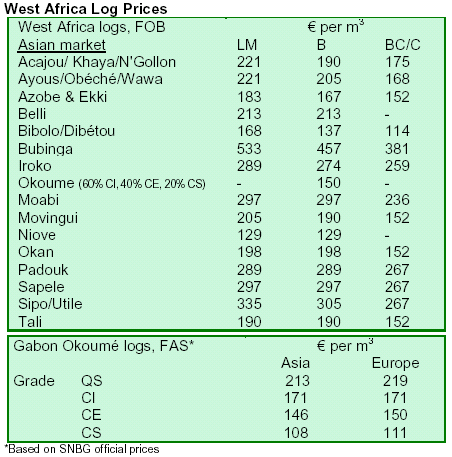
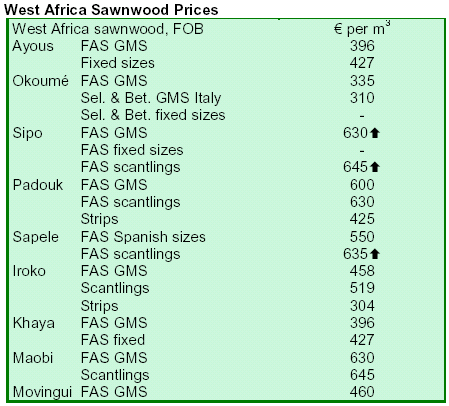
2. GHANA
Third quarter export volume jumps 21.5%
During January to September 2007, Ghana exported 399,361 m3 of timber and wood products,
earning EUR138.5 million of revenue. This represents a 10.1% increase over the EUR125.8 million
earned during the same period last year. Export volume also rose by 21.5% during
January-September 2007. Table 1 below compares Ghana¡¯s timber exports from January to
September during 2006 and 2007:
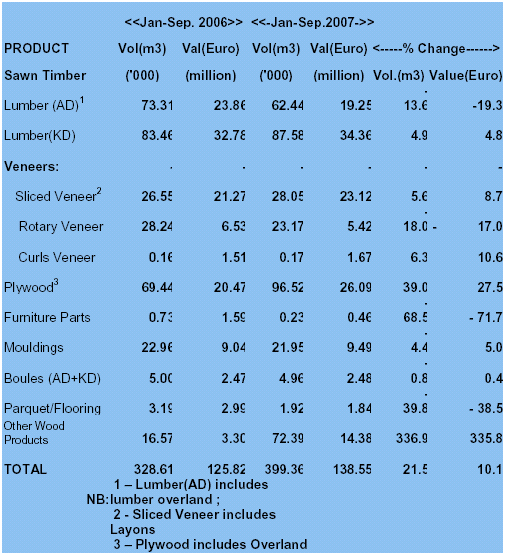
Exports to Europe amounted to EUR 58.75 million,
representing 42.4% of the earnings. The EU markets, especially Italy, France, Germany and the UK were the
key destinations for Ghana¡¯s wood products. Wood exports to India were 93,935 m3 worth EUR21.46 million,
the single highest export destination in terms of volume and value. The products shipped to India included air and
kiln dried lumber, sliced and rotary veneers, billets and teak poles. China was also emerging as an important
East Asian market for Ghana¡¯s wood products.
At the regional level, Nigeria has also become a prominent wood products market in the ECOWAS
sub-region. Nigeria¡¯s plywood imports from Ghana, during the period under review were about
EUR17.33 million, the second biggest destination for Ghana¡¯s plywood exports. This is
due in part to the robust and sustained market development and trade promotion programme, started by the
Forestry Commission. Similarly, the Forestry Commission is collaborating with timber associations
locally and overseas to enhance the performance of Ghana¡¯s timber trade and
industry in terms of species, products and market developments.
Ten companies with integrated processing facilities and high installed capacity utilization and
recovery out of 310 wood processing mills, which exported during the period under
review, contributed about EUR83.26 million (or about 60.2%) to the total earning for the period. The ten
included Mssrs. John Bitar and Co., Ayum Forest Products, Samartex Timber and Plywood, Logs
and Lumber Co. and Forune Timber (Gh), Ghana Primewood, Mondial Veneer (Gh), AG Timbers,
Fabi Timbers and Naja David Veneers and Plywood, which earlier this month was granted the
Exporter of the Year Award (for 2006) by the Ghana Export Promotion Council
(GEPC).
Ghana¡¯s export permits rise marginally
Two thousand one hundred and two (2,102) export permits were vetted, processed, approved and
issued to exporters during the third quarter of the year 2007 to cover shipment
of various wood products through the ports of Takoradi and Tema, including overland exports to neighboring
countries. The corresponding total of export permits issued for the previous quarter was 2,107. This
represented a marginal decrease of 0.24% of the number of permits issued for wood products
exports during the third quarter. Lumber air and kiln dried continued to register the highest
number of export permit applications (1,008). This was 47.95% of the total number of export permits issued
during the period under consideration.
This shows a growing demand for kiln-dried and air-dried lumber exports, compared to tertiary wood
products like furniture parts, mouldings, flooring, dowels, broomsticks and profile boards. Although
there was a substantial decrease in the number of permits issued in the third
quarter for the export of curl veneer, boules, flooring, moulding, furniture parts and plywood, a significant
increase was recorded for the export of lumber, dowels, layons, gmelina billes/poles and teak billets/poles/logs.
These could be attributed to the increase in demand for could be attributed to the increase in
demand for lumber in the European Union and expansion of demand for gmelina and teak
billets/poles/logs in India.
During the period under review, 15 export permits were issued for the shipment of air-dried levied
species (edinam and sapele), as stipulated under the Trees and Timber (Amendment) Act, 1994
(Act 493). The overall total volume was 923 m3, valued at EUR29,361. Twelve export
permits, reaching a total cumulative volume of 18,469 m3 and EUR3.61 million in value were also issued to
exporters for the shipment of teak billets, poles and logs to India. Two export permits were issued
to Best Glow Wood Ltd. for the shipment of 371 m3 of rubberwood for EUR34,027.
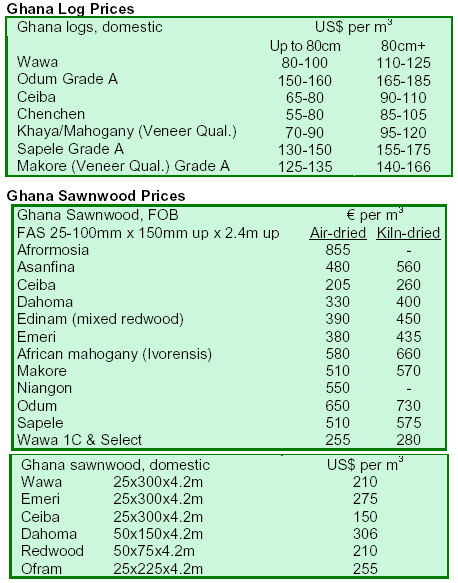
3.
MALAYSIA
Amcham urges US - Malaysia cooperation on FTA
According to the New Straits Times Online, the American Chamber of Commerce (Amcham) has
urged the US and Malaysia to finalize Free Trade Agreement (FTA) negotiations as soon as
possible. Both countries expect a number of benefits as a result of the agreement, which
they have seen in other cases of FTAs. Benefits include a higher level of foreign direct investment
(FDI), significantly higher trade levels after the FTA is implemented and greater prestige in the trading and
investment communities due to the limited amount of FTAs concluded by the US. Other benefits
expected from the new agreement include better market access within each country, the creation of
better paying jobs and supply of higher quality goods and services at lower prices. The
goal of the FTA is to also boost Malaysian producers¡¯ and exporters¡¯ competitiveness.
Malaysia is seen as an attractive country to do business with due to its sound fiscal and economic
policies, its probusiness government, capable human capital and strong infrastructure. In 2006,
Malaysia was the US¡¯s 10th largest trading partner, representing 16% of Malaysia¡¯s trade and
exports amounting to RM102.3 billion. Malaysia also imported about RM55.76 billion or 12.5% of
Malaysia¡¯s total imports in 2006. The US was also Malaysia¡¯s fourth largest foreign investor and has
contributed over RM8.5 billion in FDI.
Expansionary fiscal policy to offset negative market impacts
The Edge Daily reported on UBS Economic Research that suggested the Malaysian government
would adopt an expansionary fiscal policy in 2008 in order to offset the effect of weaker exports on
GDP and rising consumer prices. Malaysia is expected to benefit from significant oil
revenue as well as the country¡¯s political stability and recent uptrend in private investments. The UBS research
team said that banks and property would thrive in the operating environment and the construction
and building material sectors would be strengthened by the commencement of major infrastructure
projects. It was also expected that demand for oil and engineering/fabrication services would be
boosted by overseas requests.
On a more general level, the UBS research team also expected that economic growth would slow in
Asia during 2008, primarily due to the slowdown in European rather than US growth. While a major
economic meltdown was not expected in the region, the impact of slower European
exports would impact Asia less than what the US experienced in 2001. Additionally, China was expected to
be the economy least affected by the slowdown and was projected to grow by 10%.
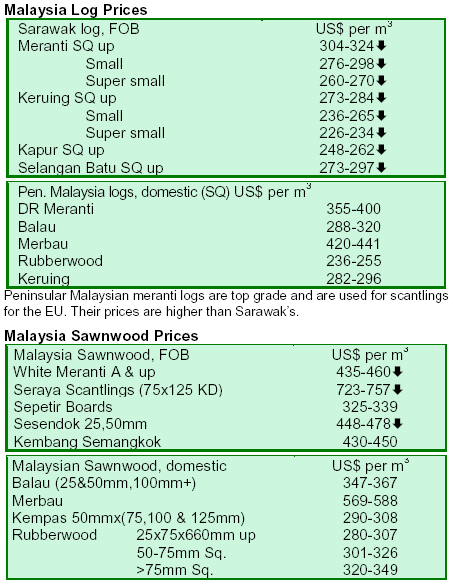
4.
INDONESIA
Indonesia gains edge in wood panel exports
Antara News reported on developments in Indonesia¡¯s wood panel exports, which were expected to
rise as a result of declining raw materials in competitor countries. The Deputy Chairman of the
Indonesia Wood Panel Association, Abbas Adhar, also noted that the rise in ecofriendly
products was giving Indonesian wood panel exports a competitive edge in the industry. He noted that
wood panel exports from Indonesia were expected to top US$2 billion next year. The volume of wood
panel exports were also expected to increase, jumping from 1.7 million m3 in 2007 to 2.5 million m3
in 2008. Other countries, such as Malaysia and China, were expected to experience
declines in raw materials availability, which some attribute to Indonesia¡¯s crackdown on illegal logging activities.
Bali COP concludes with a post-2012 roadmap
Delegates reached a conclusion on climate change negotiations at the UN Framework Convention
on Climate Change 13th Conference of the Parties (COP-13), reported the BBC. The US joined
consensus at the last minute, after objections on the Chairman¡¯s compromise text, which in
the US view did not have firm enough commitments from developing countries. The next contains language
on a ¡®Bali roadmap¡¯ that would begin a two-year process to develop emissions targets after 2012.
The Bali COP also considered the role of forests in the Kyoto Protocol and a post-2012 agreement.
A ¡®Forest Day¡¯ was organized by the Center for International Forestry Research (CIFOR) held on the
fringes of the COP negotiations to discuss how forests could contribute to cutting global emissions.
Topics included the integration of the forest sector and carbon markets, reducing
emissions from deforestation and degradation (REDD), and setting emissions baselines at the national level. The
Indonesian Minister of Forestry suggested that any post-2012 agreement should include incentives
for forest preservation. The ITTO Executive Director, Emmanuel Ze Meka, encouraged more
research to establish forestry on the climate change agenda and lamented the insufficient
attention given to forests in the Clean Development Mechanism and in the climate regime.
A decision on REDD was also adopted by the COP, which encourages Parties to the Kyoto
Protocol to, inter alia: continue reducing emissions from deforestation and forest
degradation on a voluntary basis; support capacity building initiatives and facilitate technology transfer to
developing countries; and submit views on how to address outstanding methodological issues on forests by
March 2008. One of the topics of most interest to tropical countries was how to formulate sound
and simple methodologies to assess carbon stocks in the context of REDD. The role of emissions
from deforestation and forest degradation in developing countries is expected to
play a large role in future discussions under the Protocol and in a post-2012 regime. ITTO will be convening a
meeting on SFM and climate change in spring 2008 to help the Organization plot its approach to helping
countries meet the challenges and opportunities of climate change and REDD.
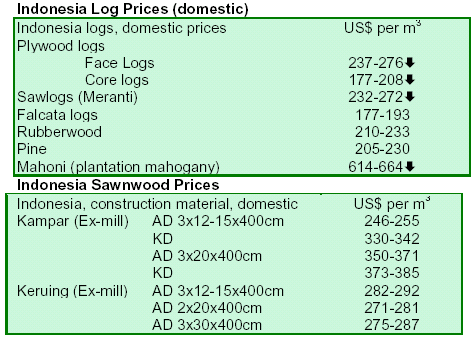
5.
MYANMAR
Market reacts cautiously to EU sanctions
The export market is said to be a bit cautious, with some experts attributing this to the latest EU
actions. Analysts say a drop in the number of local companies participating in the tender led to a
drop in average prices. However, since a small quantity is sold in the tenders, it is difficult to
assess the actual situation. A more accurate picture can be discerned from overall shipments of
logs.
Pyinkadoe logs remain in the list price range of USD470-500, which are mainly for freshly cut logs.
Logs from previous seasons are said to be traded at lower prices depending on girth and degree of
freshness. Logs with larger girths were said to be in higher demand.

6.
BRAZIL
Forest sector contributes less to Para GDP
Folha da Mata reported on the waning contribution of the forest sector to the state of Para¡¯s GDP.
The developments were announced in a report published by the Brazilian Institute of Geography and
Statistics (IBGE), which confirmed the unfavorable situation. The situation is due
to problems with the production of solid wood products. Additionally, the delayed approval of forest management
plans had been further hampered by the relocation of the State Agency for the Environment
(SEMA), which had caused the agency¡¯s overall work to be severely delayed or
suspended. This has also impacted the production of solidwood products at the end of the harvesting period.
Weak control leads to more illegal log transport
24 Hours News said illegal logging and transportation in the West-Central state of Mato Grosso has
grown over the past several months in part due to a reduction of inspections and control in the
areas. Even during the rainy season, intense traffic of illegal log trucks have been
observed in Northern Mato Grosso, where the trucks drive at dusk to avoid inspection. The state of Mato Grosso
has the longest road network in the country, of 28,000 km, although only 4,000 km is paved.
In contrast, there are only 6,800 military police responsible for controlling illegal logging and
transportation. Estimates suggest that another 6,000 policemen are needed to effectively control
illegal logging and transportation of logs. In January 2007, the state road and environmental police
forces were discontinued. As a result, there have not been sufficient controls of the most
important roads in Mato Grosso, which have been used for illegal transportation and removal of logs. Special
operations to patrol logging transportation can only be conducted when the military police is
requested to do so by the Brazilian Environmental Agency (IBAMA) and the State Secretary of
Environment (SEMA).
Northern Mato Grosso suffers slide in tropical plywood exports
The news agency REMADE has said exports of solid wood products from Northern Mato Grosso
have remained stable mostly due to the weak US dollar and lack of natural forest
logs for processing. In 2007, the total value of solid wood products from the area were USD39 million,
slightly surpassing 2006 levels, when USD36 million was exported. However, estimates from
SINDUSMAD (the Wood Product Industries Union of Northern Mato Grosso) indicate that 40% of
companies face problems staying in the market. Companies have also been impacted by the
delayed approval of forest management plans and access to raw material has proved to be
particularly difficult during the rainy season.
Despite the small increase in exports thus far for 2007, there was a decline in exports for some
products and species such as tropical plywood. Between January and October 2006, tropical
plywood exports generated USD10 million, but fell to USD1.4 million this year. Sawnwood
and laminated lumber exports also fell from USD9.2 million to USD6.2 million this year. In the domestic
market, demand is high and currently offers good business prospects. These factors have also
influenced job creation, which remained steady in 2007. According to the Federal
Employment Agency (CAGED), 3,097 new jobs were generated this year, which is still relatively small for the
sector.
Brazil takes measures to address raw materials shortage
In the last few years, investments made by lumber companies in added value products have yielded
noticeable results. In the first half of 2007, exports of solid wood products from the northern state of
Para reached USD404 million against USD295 million in the same period in 2006, representing a
36% growth. At the same time, however, the Ministry of Development, Industry and
Foreign Trade indicated the volume of exports grew only 13%, reaching 547,000 tons compared to 482,000 tons
exported in 2006. According to the Wood Exporting Companies Association of the State of Para
(AIMEX), companies managed to maintain production throughout 2007 due to log stocks from 2006
harvest. The sector was able to increase exports of higher value added products
despite the low supply of raw materials. Increasing exports of products such as doors, windows, flooring, decks,
wood tools, wood hangers and other wooden crafts primarily led to the growth in exports from
January to June of 2007.
According to the Forest Institute of Para (IDEFLOR), it is mandatory to reduce waste from wood
processing. In response, some companies have utilized wood residues in harvesting and
industrialization processes by manufacturing wood briquettes destined for energy
production as well as office objects and decorative furniture. However, sector representatives noted that the
exports in the second half of 2007 and first half of 2008 may be jeopardized by the lack of raw materials, if
sustainable forest management plans continue to be delayed.
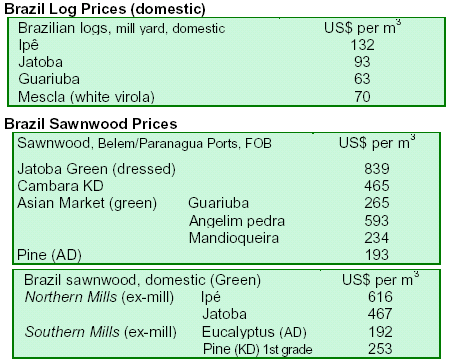
7.
PERU
Peru launches plan to recover tropical forests
Peru is fighting deforestation caused by pollution and shifting cultivation by promoting man-made
forest programmes directed to recover lost land areas. This is being carried out by the National
Institute of Natural Resources (INRENA), beginning with the introduction of several lumber species
in the Amazonian, Andean and Coastal regions.
Peru plans to reforest more than 10 million hectares devastated in the last 40 years, said the
President of INRENA, Roberto Angeles. At present, Peru has 20,000 hectares of planted forests
with 200 people employed. In contrast, there are six million hectares of cultivated forests
in Brazil with 800,000 people at work. Peru is attempting to avoid the exploitation of materials used for
lumberresources, including sapling species of eucalyptus, pines, alders, cypresses, ashes,
casuarinas, chestnuts, and poplars, among others.
The measures are also in response to a recent World Bank report revealing Peru¡¯s experiences with
environmental degradation that cost nearly USD2.6 billion dollars. The report noted that the primary
drivers of this economic loss were deforestation, natural disasters and atmospheric
pollution. The World Bank recommended that Peru make efforts to prevent uncontrollable land and natural
resource use, in an effort to avoid the type of destruction that has previously occurred in the
Amazon region. It also recommended the control of unplanned colonization. According to the World
Bank, Peru is recognized as one of 12 countries that house 70% of the world¡¯s biological
diversity and a large number of endemic species. The World Bank is also aware the country has undertaken
conservation efforts to establish natural protected areas covering 13.74% of Peru¡¯s territory.
Peru chalks marginal gains in third quarter wood products exports
From January ¨C September 2007, wood products exports were USD153.6 million, rising from 2006
levels by 3.38%. September 2007 exports increased by USD4.58 million compared to exports in the
same period of 2006. The items with the highest growth in the period of January
to September 2007 were furniture and components (rising 18.08%), as well as semi-manufactured products (15.92%)
and wood sheets and plywood (14.34%). Products with decreased export value were sawnwood
(3.67%), structural timber (2.94%) and veneers (93.39%).
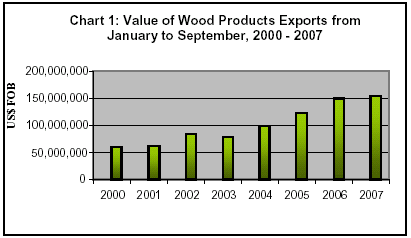
Sawnwood was still the main item exported, representing
51.04% of overall sector exports. FOB Exports at the end of the third quarter amounted to USD78.4 million,
showing a 3.67% decline from 2006 levels. However, exports in September 2007 alone rose USD3.5 million
compared with the same period in 2006.
Semi-manufactured products accounted for a share of 26.1% of the overall sector. Exports reached
USD40.2 million during January ¨C September 2007, rising 15.9% compared to the total value during
the same period of 2006. Exports of semi-manufactured products for September 2007 rose
modestly by USD452,628 compared to the same period in 2006.
By the end of the third quarter of 2007, exports of furniture and components reached USD12.69
million, jumping 18.09% from the same period in 2006. Exports of wood sheets and plywood for
the same period rose 14.34%, reaching a total value of USD16.48 million.
The three main markets for the Peruvian wood exports during January to September in 2006 and
2007 were the US, Mexico and China. Exports to the US fell 12.4% and its market share dropped
to 33.3% in 2007 from 39.3% in 2006. Mexico, the second destination market, increased its
imports by 16.87%, 30.1% of Peru¡¯s total market share. China, the third largest destination market,
reached similar import levels to 2006, holding a steady share of Peru¡¯s wood products exports at
around 20%.
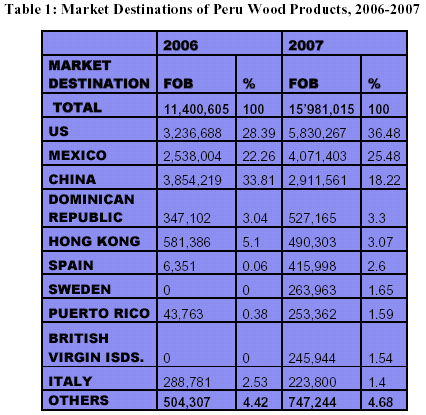
USD$22 million of wood products shipped from Iquitos
From January to September 2007, USD22 million worth of lumber, measuring 30.0 billion board feet, were shipped
from the National Ports Enterprise (ENAPU) of Iquitos. Products were shipped through the port to the Gulf of
Mexico and the US with the Agencia Naviera Maynas, S.A., the only Peruvian flag line, and other Brazilian
companies. Wood products exports from Loreto have steadily grown during the last 12 years,
generating foreign currency for the region. At present, increased prices and
the volumes of wood products in the market have helped the capacity and technology level of the forest industry in
the region.
Wood products play an important role in the Loreto region¡¯s economy. According to the Loreto
Chamber of Commerce, Industry and Tourism, the wood products sector is expanding activities in
the region. According to figures also given by the economic studies department of
the Central Reserve Bank of Peru, Iquitos branch, the Loreto region total exports were USD32.4 billion from
January to August 2007, with the share of wood products at USD23.2 billion, or 71.6% of the total.
As in previous years, Mexico is the main destination market of wood products exports, receiving
83.5% of overall wood products from Peru. The EU accounts for the remaining 16.5% of the region¡¯s
wood products exports.

8.
MEXICO
Mexico¡¯s Hidalgo region is model for forest
management
According to the Revista Mexico Forestal, the Hidalgo region in Zacualtipan-Molango has emerged
as an exemplary site for forest management activities. The area has transformed into a
well-functioning forest management unit (FMU), and is known for its sustainably
managed forests and ability to plan forest management activities. Pine, encino and liquidambar species are
existent in the zone, consisting of over 7 thousand hectares. The National Forest Commission
(CONAFOR) and the Government of the State of Hidalgo, through the Secretariat of Agriculture and Rural
Development, have provided over 7 million pesos worth of funds through Mexico¡¯s ProTree
programme to help form and implement FMU activities in the Hidalgo region.
Anti-logging raid conducted near Monarch reserve
The Associated Press has reported Mexico¡¯s police raided a sawmill that cut timber near a
Monarch butterfly reserve. Agents seized about 600 truckloads of logs, making it the
largest seizure in Mexico¡¯s history. Reports say that evidence of the cutting shows failures to stick to pledges
to end illegal logging and revealed that over 6,000 tons of wood were cut from the Monarch butterfly
reserve. The reserves are an important breeding ground for Monarch butterflies in the winter.
Recently, police raided 19 other mills in the region, resulting in the detention of 56 people.
9.
PANAMA
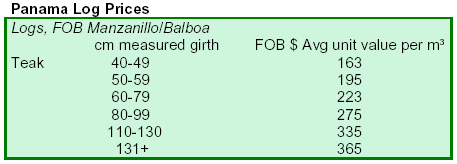
10.
BOLIVIA
Fuel scarcity slows Bolivia¡¯s wood exports growth
Bolivian wood exports have slowed during August to September 2007. During the two month period,
exports grew 18% compared to the period of March to July 2007. The slower growth was caused by
fuel scarcity, since the control of oil shifted from Petrobras (Brazil) to YPFB (a
Bolivian oil company). At present, there are serious levels of inefficiency associated with production levels,
which at times have cut the companies' production capacity in half.
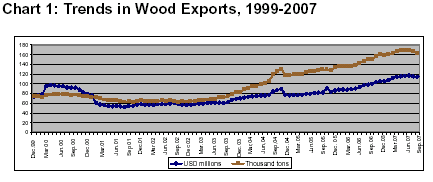

11.
GUYANA
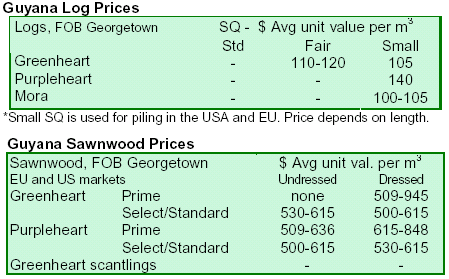
|